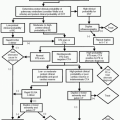Intussusception
Alexander M. Kowal
Intussusception is the acquired telescoping of one portion of bowel (the intussusceptum) into another portion of bowel (the intussuscipiens).
Age at presentation.
Intussusception is the most common abdominal emergency of infancy and the second most common cause of acute abdomen in children, after appendicitis. Both the incidence and etiology of intussusception are highly dependent on the age of the patient. The vast majority (75-80%) of intussusceptions occur in young children between the ages of 3 months to 2 years. The peak incidence is between 5 and 10 months with 50% younger than 1 year. Intussusceptions almost never occur before 3 months of age. After 2 years of age, the incidence declines progressively with only 5% presenting in adult patients. There is a 2-4:1 male predominance. Early diagnosis is the key to avoiding complications including bowel obstruction, necrosis, and bowel perforation.
Etiology in Children.
In young children, equal to ormore than 90% of intussusceptions are idiopathic with no identified pathologic lead point. These intussusceptions are virtually always ileocolic and are probably due to hypertrophied lymphoid tissue (Peyer’s patches) in the distal ileum acting as a lead point. A higher incidence in the spring and autumn suggests a predisposing viral infection. After 4 years of age, the likelihood of a pathologic process causing intussusception begins to rise with the patient’s age.
Differential diagnosis of pathologic lead points in children includes inverted Meckel’s diverticulum, lymphoma, polyp, duplication cyst, enterogenous cyst, intramural hematoma (Henoch-Schönlein purpura), hemangioma, appendiceal inflammation, suture line from prior surgery, and inspissated meconium in the setting of cystic fibrosis.
Etiology in Adults.
In adults, a specific cause or pathologic lead point is identified in equal to or more than 80% of patients with intussusception. The site of intussusception in older patients is variable. The enteroenteral type is most frequent and often related to a benign condition such as lipoma, gastrointestinal stromal tumor (GIST), adenomatous polyp, hemangioma, adhesions, lymphoid hyperplasia, or villous adenoma of the appendix. Transient, asymptomatic small bowel intussusceptions have been increasingly identified. Colonic intussusception is most often due to a malignancy such as adenocarcinoma or lymphoma but may also be due to leiomyoma, endometriosis, or a prior surgical anastomosis.
Differential diagnosis of pathologic lead points in adults also includes benign and malignant tumors, Meckel’s diverticulum, aberrant pancreatic tissue, foreign body, feeding tube, chronic ulcer, prior gastroenteritis, gastroenterostomy, and trauma. In addition, intussusception can be seen without any specific lead point in adults with scleroderma, Whipple’s disease, celiac disease, and fasting states.
Symptoms and Signs.
In children, the classic triad of colicky intermittent abdominal pain, palpable mass, and red currant jelly stools is present in fewer than 50% of cases. Blood in the stool mixed with sloughed mucosa is a late finding, producing the characteristic “currant jelly” appearance. Infants are often irritable, may have episodes of emesis, and cry intermittently. Lethargy can accompany any one of the above symptoms. Twenty percent are painfree at presentation. Physical examination may reveal a palpable sausage-shaped
mass, which can increase in size during paroxysms of pain. In adults, intussusception usually presents with nonspecific symptoms of mechanical obstruction.
mass, which can increase in size during paroxysms of pain. In adults, intussusception usually presents with nonspecific symptoms of mechanical obstruction.
Indications.
Ultrasonography is considered the primary imaging technique for suspected intussusception. Sensitivity is 98-100%, specificity is 88-100%, negative predictive value is 100% and the reported accuracy is 100%. The procedure is noninvasive, fast, easy, and reproducible and does not require ionizing radiation. It can detect up to 66% of pathologic lead points.
Possible Findings (Fig. 32-1)
An oval-shaped mass on longitudinal ultrasonography with a sonolucent rim and an echogenic center. This has been termed the pseudokidney appearance because it resembles the sagittal view of a kidney. The mass may also have a “sandwichlike” appearance of three parallel hypoechoic bands.
On transverse views, intussusception appears as a “doughnut” with a sonolucent ring and echogenic center.
In both views, the sonolucent rim is caused by the edematous wall of the intussuscipiens and the echogenic center corresponds to compressed mucosa and associated mesenteric fat of the intussusceptum.
The mass is often seen just deep to the right abdominal wall and measures between 2.5-5 cm.
Color Doppler is helpful to detect blood flow within the bowel wall. A lack of Doppler signal may suggest ischemia, and indicates that the chance of nonoperative reduction is decreased.
Trapped peritoneal fluid between serosal surfaces (<15%) is associated with decreased reduction rates and suggests ischemia.
Stay updated, free articles. Join our Telegram channel

Full access? Get Clinical Tree



